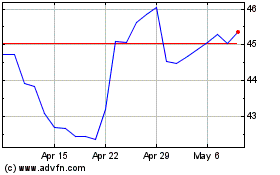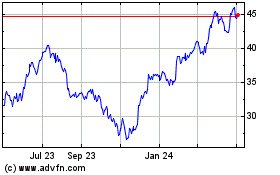By Dieter Holger
After seeing an artificial heart on a 1980s television show,
Telva McGruder started thinking she might want to become an
engineer.
When Ms. McGruder asked her parents about the heart, her father
gave his usual suggestion: "Go to the library." That set Ms.
McGruder, a woman of color, on a path of learning that ultimately
helped her move into a leadership role in engineering at General
Motors Co., one of the 20 most diverse companies in the S&P
500, according to a new ranking by The Wall Street Journal's
research analysts.
The 50-year-old Ms. McGruder, who has worked at the
Detroit-based auto maker for over 25 years, grew up in Dayton,
Ohio, with her mother and father, who operated a piston
rod-grinding machine at GM's factory there. Her parents joked that
everyone knew at least one person who worked at GM.
Ms. McGruder went on to earn bachelor's and master's degrees in
electrical engineering from Purdue University in Indiana. In
college, she was often the only woman in her classes and among the
very few people of color. "The environment proved a little bit
shocking," she says, adding that had she known how rare it was for
women and minorities to study engineering, she might have chosen a
different path.
Decades later, not much has changed. As recently as 2015, the
engineering field was 70% white and 85% male. About 4% of
engineering jobs in the U.S. were held by black people, and less
than 2% were held by black women, according to the National Science
Foundation. Meanwhile, the number of African-Americans earning
bachelor's degrees in engineering has remained little changed since
2010, hovering around 4%, according to the American Society for
Engineering Education.
In the first diversity and inclusion ranking by The Wall Street
Journal's environmental, social and governance research team, the
industrial sector -- a big employer of engineers -- ranked seventh
out of 11 sectors in the S&P 500. The energy and materials
sectors, also big employers of engineers, tied for last.
The consumer-discretionary sector to which GM belongs ranked
fourth, but the company earned high marks on ethnic diversity, as
well as gender diversity of its board, senior management and
workforce.
Like other top performers in the study, GM supports and recruits
from college associations for women and people of color and sends
diverse engineers to classrooms in low-income areas to get children
interested in science.
Attracting a more diverse population of engineering students may
be needed to help counter looming labor shortages.
"Our country needs more African-American engineers to continue
our nation's progress and fill talent gaps," says Karl Reid,
executive director of the National Society of Black Engineers. He
says challenges include an absence of role models for black
students and opportunities for engineers of color to develop
professionally.
At GM, Ms. McGruder is now helping lead the charge on those
issues. Along with holding the title of director of workplace
engineering and operations solutions, she is the president of the
General Motors African Ancestry Network, which has provided
mentorship and networking for GM employees since 1999.
The group, she says, has helped elevate the voices of people of
color at GM by encouraging them to work together. "Different
organizations will come to GMAAN and ask for our input on product
decisions," Ms. McGruder says.
To get younger people of color interested in engineering, the
group visits K-12 classrooms in the Detroit area, and creates
robotics teams to help students develop a passion for coding or
electrical engineering. GM engineers of color also offer advice on
college applications.
While the number of African-Americans earning engineering
degrees hasn't changed much in recent years, the needle does seem
to be moving for Hispanics, who earned 11.4% of the engineering
degrees awarded in 2018, up from 7% in 2010, according to the
American Society for Engineering Education.
Hispanics are the fastest-growing ethnic group in the U.S.,
which could explain some of the growth. But some in the field say
efforts to encourage Hispanic youth to pursue science also is
having an effect. "I think part of the reason you're going to see a
big pickup in Hispanics in STEM is that we are going back as a
community and helping the community," says William Gonzalez, an
account manager at Rockwell Automation Inc., where he also helps
recruit engineers and mentor youth.
Born to Nicaraguan immigrants who came to the U.S. in 1989, Mr.
Gonzalez, now 25, lived in a trailer park in Miami-Dade County,
Fla., until he was 12. He earned a bachelor's degree in industrial
engineering from the University of South Florida in 2017, and
completed engineering internships at Northrop Grumman Corp. and
Eaton Corp. before joining Rockwell, where he handles sales of
automation products to mostly oil and chemical companies in the
Houston area.
Rockwell scored better than 61% of S&P 500 companies in the
industrials sector and 50% over the overall index, according to the
study by The Wall Street Journal research analysts. It earned top
marks for age diversity among board members and senior management
and for workforce ethnic diversity.
Like GM, Rockwell also is trying to boost interest in
engineering among young people of color. Mr. Gonzalez, for example,
helps form robotics teams at K-12 schools in low-income areas that
Rockwell then supports with up to $6,000 a season.
At high schools, parents have asked Mr. Gonzalez if their
children should continue family businesses such as painting or
pursue college. "I ask them, 'Do you want more for your son than
what you have, or do you want him to keep doing what you do?' " he
says. "Their answer is always, 'I want more.' "
Mr. Holger is a reporter for The Wall Street Journal in
Barcelona. Email him at dieter.holger@wsj.com.
(END) Dow Jones Newswires
October 26, 2019 08:14 ET (12:14 GMT)
Copyright (c) 2019 Dow Jones & Company, Inc.
General Motors (NYSE:GM)
Historical Stock Chart
From Aug 2024 to Sep 2024

General Motors (NYSE:GM)
Historical Stock Chart
From Sep 2023 to Sep 2024
